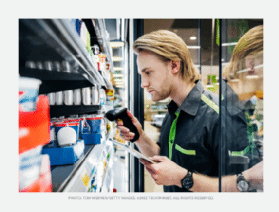barcode reader
What is a barcode reader (POS scanner, barcode scanner, price scanner)?
A barcode reader, also called a price scanner or point-of-sale (PoS) scanner, is a hand-held or stationary input device used to capture and read information contained in a barcode.
A barcode reader comprises a scanner, a decoder (either built-in or external), and a cable used to connect the reader with the computer or POS system.
How do barcode readers work?
Because a barcode reader merely captures and translates the barcode into numbers and/or letters, the data must be sent to a computer so a software application can translate the data into information.

Barcode scanners can be connected to a computer through a serial port, keyboard port or interface device called a wedge. A barcode reader works by directing a beam of light across the barcode and measuring the amount and pattern of the light that is reflected.
The scanner converts the light energy into electrical energy, which is then converted into data by the decoder and forwarded to a computer.
What are the advantages of barcode readers?
Barcode readers offer several advantages in retail environments:
- reduced pricing errors
- increased accuracy and efficiency
- improved customer service
- reduced inventory levels
What are some common use cases for barcode readers?
The most common barcode reader use cases include retail POS systems, inventory management and asset performance management (APM).

In retail POS systems, barcode scanners are used to capture product information so that it can be added to the customer's purchase total.
Inventory management systems use barcode scanners in supply chain applications to track products from the time they are received into the warehouse until they are shipped out.
All these retail applications help businesses keep accurate records of their inventory levels and ensure products are available when customers need them.
How many types of barcode readers are there?
There are two types of barcode readers: handheld and fixed position.
- Handheld barcode readers are used in a wide variety of settings, including retail stores, warehouses and office buildings.
- Fixed-position barcode readers are generally used in manufacturing and logistics applications to track inventory or products as they move through the production process.
Barcode readers come in many forms depending on their use case:
- Pen wand barcode readers contain no moving parts and are known for their durability and low cost. They are typically used to scan barcodes that are printed on paper labels -- for example, in libraries, package delivery and office settings.
- Slot scanners remain stationary, and the item bearing the bar code is pulled through the slot manually. Slot scanners are typically used to scan bar codes on identification cards -- for example, for time and attendance tracking or physical access control.
- CCD scanners have a better read range than pen wands and are often used in retail sales via a "gun" type interface that is held only one inch from the bar code. Each time the bar code is scanned, several readings are taken to reduce the possibility of errors.
- Image scanners use a small video camera to capture an image of the bar code and then use sophisticated digital image processing techniques to decode the information in the barcode. An image scanner can read a bar code from about 3 to 9 inches away and typically costs less than a laser scanner.
- Laser scanners, either hand-held or stationary, use a system of mirrors and lenses to allow the scanner to read the barcode regardless of orientation and can easily read a bar code up to 24 inches away.
- 3D scanners create a three-dimensional image of the bar code, which allows it to be read from any angle. 3D barcode scanners are typically used in industrial settings, such as automotive assembly or aerospace manufacturing. Barcode readers are a critical part of many businesses, and their barcode scanning needs vary depending on the industry and application.
- CGI scanners are used to read barcodes that are printed on curved surfaces, such as cans or pipes. CGI scanners are typically used in the food and beverage industry.
Are there any disadvantages to using barcode readers?
There are a few disadvantages to barcode readers:
- The possibility of misreads, which can lead to data errors;
- The need for a clear line of sight between the barcode and the scanner; and
- The need for barcodes to be printed on labels or tags.
How can I ensure accurate barcode reads?
There are several ways to ensure accurate barcode reads:
- Keep barcodes clean and free of smudges or dirt.
- Make sure barcodes are printed clearly and at the proper resolution.
- Ensure barcodes are the correct size for the scanner being used.
- Use high-quality barcode labels or tags.
Barcode readers are a versatile and essential tool for businesses of all types and sizes.
With their many advantages, including increased accuracy and efficiency, barcode readers can help businesses improve their bottom line.
While there are a few disadvantages to using barcode readers, they can be minimized with proper barcode labelling and tag quality. When used correctly, barcode readers provide an invaluable service to businesses and organizations that need to manage and track inventory and retail goods.
See also: Bar Coded Medication Administration, quiet zone, 2D barcode, QR code, RFID
